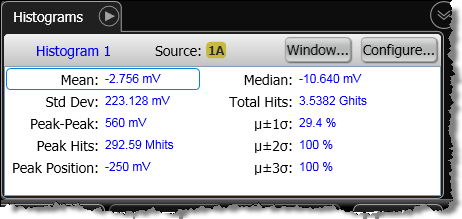:MEASure:HISTogram:PPOSition?
Query Syntax
:MEASure:HISTogram{1:4}:PPOSition?
Description
Returns Peak Position, position of the greatest peak of the histogram as reported on the Histograms results table. If there is more than one peak, then it returns the position of the first peak from the lower boundary of the histogram window for vertical axis histograms. Otherwise, in the case of horizontal axis histograms, it returns the position of the first peak from the leftmost boundary of the histogram window.

Measurement Ready?
To confirm that the measurement is ready to read, you can query the measurement's status:
if ('CORR' in Flex.query(':STATus?')):
measurement = Flex.query('?')
If averaging is turned on (:ACQuire:AVERaging), you can also confirm if the measurement result is ready by comparing the number of specified averages (:ACQuire:ECOunt?) versus the number of measurement sweeps that have occurred (:COUNt?). The technique uses the :COUNt? common measurement query. For example,
if (Flex.query(':COUNt?') >= Flex.query(':ACQuire:ECOUNt?')):
measurement = Flex.query('?')
You can also use an acquisition limit lest to test that a number of waveform samples, or pattern acquisitions have completed before returning a measurement. Refer to the :LTESt:ACQuire:CTYPe command.
Common Measurement Child Queries
This command supports the use of the following common measurement queries: :LOCation?, :COUNt?, :MAXimum?, :MINimum?, :MEAN?, and :SDEViation?.